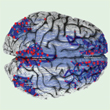Monday, 15 July 2013
The Brain’s Default Network

What does the human brain do when it’s not doing anything in particular? At first glance, this question might seem of little interest, and for many years most brain researchers paid little attention to it. But over the past 10 years or so, it has become one of the hottest and most intriguing research topics in neuroscience: the activity of the brain’s default network.
The default network is a set of areas in the brain that are connected to one another, in some cases across large distances (in terms of the brain’s size). They are activated preferentially when the individual is not performing any specific task. Scientists do not yet know exactly what purpose this default brain activity serves. But they do already know that the areas involved in the default network are more active when our minds are wandering (when we have “our heads in the clouds”), when we are evoking personal memories, and when we are trying to imagine ourselves in future situations or to understand someone else’s point of view.
These brain areas include parts of the medial temporal lobe, the medial prefrontal cortex, the posterior cingulate cortex, the precuneus and other adjacent areas of the parietal cortex (click here to enlarge the image above). Also, the default network seems to be far less developed in children less than 10 to 12 years old, which suggests that it undergoes significant developmental maturation.
Historically, the possibility that such a network is active by default in the brain can be traced to a debate that goes back at least as far as the late 1920s, when Hans Berger, the inventor of electroencephalography (EEG), demonstrated that the brain engages in a large amount of intrinsic activity and is far from inactive even when it is not receiving any stimulus from its environment. Still earlier, in 1914, Graham Brown had argued that the brain engages in spontaneous activity even in the absence of external stimuli, and that such stimuli only alter activity that is already there.
Previously, other scientists, such as Sherrington in 1906, had proposed the opposite view: that the brain is an organ that simply reacts to the tasks and problems presented to it by the outside world. Later in the 20th century, this conception of the brain as a passive machine that simply processes the information it receives was embraced by the computational or cognitivist approach that came to dominate the cognitive sciences. And since they first began, brain imaging studies had always been based on the idea that you activate certain areas of the brain by making them perform a given task.
But in the late 1990s, a number of studies, such as those done in Marcus E. Raichle’s laboratory, began to raise questions about this classic cognitivist conception of the brain and instead suggest a more dynamic approach in which the intrinsic activity of the brain’s neural circuits was far more important.
For example, Raichle and other researchers showed that the brain, though it accounts for only about 2% of the body’s weight, constantly burns about 20% of all the energy that the body consumes, and that the energy consumed by the brain increases remarkably little (less than 5%) when it is performing a specific task.
Geneticists once used the term “junk DNA” to refer to genetic material that had no known function, but now they are learning more and more about its importance. Similarly, neuroscientists who want a more complete understanding of how the brain works will now have to consider not only the brain activity that is invoked by stimuli, but also the activity that is already occurring in the brain’s default network when no stimulus is applied.
![]() NEUROSCIENTISTS: WHAT’S THE MOST INTERESTING QUESTION RIGHT NOW?
NEUROSCIENTISTS: WHAT’S THE MOST INTERESTING QUESTION RIGHT NOW?
![]() Les fonctions importantes de l’esprit au repos
Les fonctions importantes de l’esprit au repos
![]() Default network
Default network
![]() A Paradigm Shift in Functional Brain Imaging
A Paradigm Shift in Functional Brain Imaging
The Emergence of Consciousness | Comments Closed







